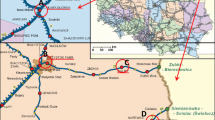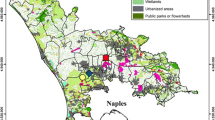Abstract
Polycyclic aromatic hydrocarbons (PAHs) and heavy metals are the two most important groups of pollutants associated with rail transport. Both have a serious negative impact on the natural environment, including human health and degradation of sensitive ecosystems. In our study, apart from qualitative and quantitative analysis of the main PAHs and heavy metals associated with rail, we tried to assess composition of specific compounds related to functional areas of railway infrastructure and to distinguish potential chemical markers which can be used for identification of pollution. Moreover, we evaluated the applicability of plants overgrowing railway infrastructure as bioindicators of rail-associated pollution. Though we confirmed that high amounts of PAHs and heavy metals in soil are characteristic for intensively used railway infrastructure, we found no typical pollution profiles for the differently used areas (i.e. platforms, sidings, cleaning bays). The major source of these contaminants is petroleum products used in conservation of railway infrastructure and rolling stock. As far as the use of plants overgrowing railway infrastructure as bioindicators of rail-associated pollution is concerned, it is rather limited, due to frequent application of herbicides for security and track stability reasons.





Similar content being viewed by others
References
Breu, F., Guggenbichler, S. Wollmann, J., 2008. Vasa, 40 (40), pp.1–7. Available at: http://medcontent.metapress.com/index/A65RM03P4874243N.pdf [Accessed June 12, 2014].
Bukowiecki, N., Gehrig, R., Hill, M., Lienemann, P., Zwicky, C. N., Buchmann, B., & Baltensperger, U. (2007). Iron, manganese and copper emitted by cargo and passenger trains in Zürich (Switzerland): size-segregated mass concentrations in ambient air. Atmospheric Environment, 41(4), 878–889. Available at: http://linkinghub.elsevier.com/retrieve/pii/S1352231006008739 [Accessed December 12, 2013].
Burkhardt, M., Rossi, L., & Boller, M. (2008). Diffuse release of environmental hazards by railways. Desalination, 226(1–3), 106–113. Available at: http://linkinghub.elsevier.com/retrieve/pii/S0011916408001410 [Accessed December 12, 2013].
Cachada, A., Pato, P., Rocha-Santos, T., Ferreira da Silva, E., Duarte, A. C. (2012). Levels, sources and potential human health risks of organic pollutants in urban soils. Science of the Total Environment 430, 184–192.
Chen, Z., Wang, K., Ai, Y. W., Li, W., Gao, H., & Fang, C. (2013). The effects of railway transportation on the enrichment of heavy metals in the artificial soil on railway cut slopes. Environmental Monitoring and Assessment, 186(2), 1039–1049.
Galera, H., Sudnik-Wojcikowska, B., Wierzbicka, M., Wilkomirski, B. (2011). Encroachment of forest species into operating and abandoned railway areas in north-eastern Poland. Plant Biosystem, 145.
Ikarashi, Y., Kaniwa, M., & Tsuchiya, T. (2005). Monitoring of polycyclic aromatic hydrocarbons and water-extractable phenols in creosotes and creosote-treated woods made and procurable in Japan. Chemosphere, 60(9), 1279–1287. Available at: http://www.ncbi.nlm.nih.gov/pubmed/16018899 [Accessed December 12, 2013].
Jiang, Y.-F., Wang, X.-T., Wang, F., Jia, Y., Wu, M.-H., Sheng, G.-Y., & Fu, J.-M. (2009). Levels, composition profiles and sources of polycyclic aromatic hydrocarbons in urban soil of Shanghai, China. Chemosphere, 75(8), 1112–1118. Available at: http://www.ncbi.nlm.nih.gov/pubmed/19201443 [Accessed December 12, 2013].
Kluge, B., & Wessolek, G. (2012). Heavy metal pattern and solute concentration in soils along the oldest highway of the world—the AVUS Autobahn. Environmental Monitoring and Assessment, 184(11), 6469–6481.
Kohler, M. & Kunningen, T. (2003). Emissions of polycyclic aromatic hydrocarbons (PAH) from creosoted railroad ties and their relevance for life cycle assessment (LCA). 61, pp.117–124.
Kohler, M., Ku, T., Schmid, P., Gujer, E., & Crockett, R. (2000). Inventory and emission factors of creosote, polycyclic aromatic hydrocarbons (PAH), and phenols from railroad ties treated with creosote. Environmental Science and Technology, 34(22), 4766–4772.
Lampropoulou, A., Becker, È., Spyra, W., Ochsenku, M. (2001). Polycyclic aromatic hydrocarbons in wooden railway beams impregnated with coal tar : extraction and quanti ® cation by GC-MS, Microchimica Acta 191.
Liu, J. (2012). Assessing vegetation cover changes induced by livestock grazing in the Alai Valley, the Kyrgyz Republic in and after the Soviet time assessing vegetation cover changes induced by livestock grazing in the Alai Valley, the Kyrgyz Republic in and after the.
Liu, H., Chen, L.-P., Ai, Y.-W., Yang, X., Yu, Y.-H., Zuo, Y.-B., & Fu, G.-Y. (2008). Heavy metal contamination in soil alongside mountain railway in Sichuan, China. Environmental Monitoring and Assessment, 152(1–4), 25–33.
Lorenzo, R., Kaegi, R., Gehrig, R., & Grobéty, B. (2006). Particle emissions of a railway line determined by detailed single particle analysis. Atmospheric Environment, 40(40), 7831–7841. Available at: http://linkinghub.elsevier.com/retrieve/pii/S1352231006007874 [Accessed March 5, 2015].
Malawska, M., & Wiłkomirski, B. (2001). An analysis of soil and plant (taraxacum officinale) contamination with heavy metals and polycyclic aromatic hydrocarbons (PAHs) in the area of railway junction Iława Główna, Poland. Water, Air, and Soil Pollution, 127, 339–349. Available at: http://link.springer.com/article/10.1023/A:1005236016074.
Mazur, Z., Radziemska, M., Maczuga, O., & Makuch, A. (2013). Heavy metal concentrations in soil and moss (Pleurozium schreberi) near railroad lines in Olsztyn (Poland). Fresenius Environmental Bulletin, 22(4), 955–961.
Rybak, J., & Olejniczak, T. (2013). Accumulation of polycyclic aromatic hydrocarbons (PAHs) on the spider webs in the vicinity of road traffic emissions. Environmental Science and Pollution Research, 21(3), 2313–2324.
Sun, L., Liao, X., Yan, X., Zhu, G., & Ma, D. (2014). Evaluation of heavy metal and polycyclic aromatic hydrocarbons accumulation in plants from typical industrial sites: potential candidate in phytoremediation for co-contamination. Environmental Science and Pollution Research International, 21(21), 12494–12504. Available at: http://www.ncbi.nlm.nih.gov/pubmed/24946706 [Accessed March 19, 2015].
Thierfelder, T., & Sandström, E. (2008). The creosote content of used railway crossties as compared with European stipulations for hazardous waste. The Science of the Total Environment, 402(1), 106–112. Available at: http://www.ncbi.nlm.nih.gov/pubmed/18558221 [Accessed December 12, 2013].
Tiwari, A. V., Kadu, P. A., & Mishra, A. R. (2013). Study of noise pollution due to railway and vehicular traffic at level crossing and its remedial measures. American Journal of Engineering Research, 4, 16–19.
Wierzbicka, M., Bemowska-Kalabun, O., Gworek, B. (2015). Multidimensional evaluation of soil pollution from railway tracks. Ecotoxicology (London, England), 1.
Wilkomirski, B., Galera, H., Staszewski, T., Sudnik-Wojcikowska, B., & Malawska, M. (2012). Railway tracks—habitat conditions, contamination, floristic settlement—a review. Environment and Natural Resources Research, 2(1), 86–95. doi:10.5539/enrr.v2n1p86.
Wiłkomirski, B., Sudnik-Wójcikowska, B., Galera, H., Wierzbicka, M., & Malawska, M. (2011). Railway transportation as a serious source of organic and inorganic pollution. Water, Air, and Soil Pollution, 218(1–4), 333–345. Available at: http://www.pubmedcentral.nih.gov/articlerender.fcgi?artid=3096763&tool=pmcentrez&rendertype=abstract [Accessed December 12, 2013].
Wittig, R. (2002). Ferns in a new role as a frequent constituent of railway flora in central Europe. Flora - Morphology, Distribution, Functional Ecology of Plants, 197(5), 341–350. Available at: http://linkinghub.elsevier.com/retrieve/pii/S0367253004700341.
Yunker, M. B., Macdonald, R. W., Vingarzan, R., Mitchell, H., Goyette, D., & Sylvestre, S. (2002). PAHs in the Fraser River basin: a critical appraisal of PAH ratios as indicators of PAH source and composition. Organic Geochemistry, 33, 489–515.
Zhang, H., Wang, Z., Zhang, Y., & Hu, Z. (2012). The effects of the Qinghai-Tibet railway on heavy metals enrichment in soils. The Science of the Total Environment, 439, 240–248. Available at: http://www.ncbi.nlm.nih.gov/pubmed/23079687 [Accessed December 12, 2013].
Acknowledgments
We thank the administration of the Polish State Railways for enabling us the performance of field studies. We are grateful to M.Sc. Beata Wójcik and Iwona Ładziak, for the help in laboratory work.
The study was carried out at the Biological and Chemical Research Centre, University of Warsaw, established within the project co-financed by the European Union from the European Regional Development Fund under the Operational Program Innovative Economy, 2007–2013.
Funding
This work was supported by the Ministry of Higher Education and Science (Grant No N N305 052440).
Author information
Authors and Affiliations
Corresponding author
Rights and permissions
About this article
Cite this article
Mętrak, M., Chmielewska, M., Sudnik-Wójcikowska, B. et al. Does the Function of Railway Infrastructure Determine Qualitative and Quantitative Composition of Contaminants (PAHs, Heavy Metals) in Soil and Plant Biomass?. Water Air Soil Pollut 226, 253 (2015). https://doi.org/10.1007/s11270-015-2516-1
Received:
Accepted:
Published:
DOI: https://doi.org/10.1007/s11270-015-2516-1




